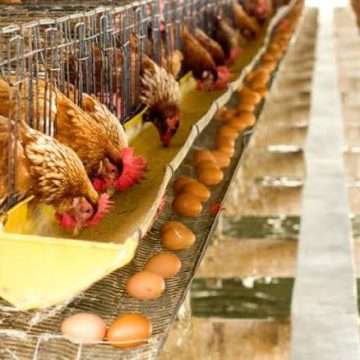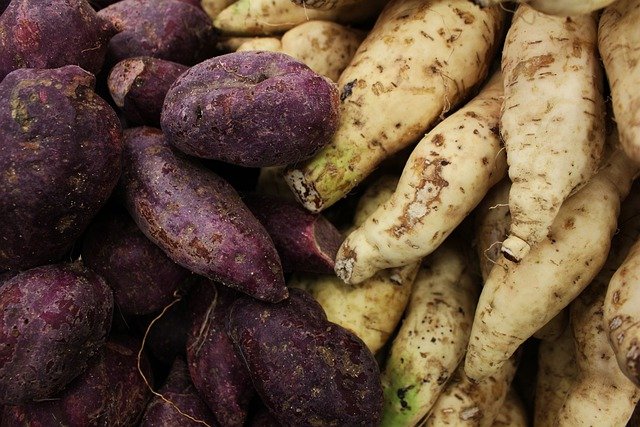Sweet potato is one of the root crops with a relatively high nutritive value and yet only about 5% of world production comes Africa.
It is mostly grown with other arable crops.
Asia produces over 90% of the crop with China alone accounting for over 85% of world production.
Origin
It originated from central and parts of south America where it has been grown for many centuries.
It was introduced into Europe in the sixteenth century and probably came into Africa from Europe.
Ecology
The cultivation of sweet potato is limited to the hot, moist regions of the tropics and subtropics where the average annual temperature is not less than 19°C.
It requires a warm sunny climate, a long growing season and a liberal moisture in the growing season except for the tuber maturing phase.
A well distributed rainfall of 750-1000mm/annum is best for the crop. It can grow at low altitudes (lowlands) as well as high altitudes of up to 2750m in the tropics.
It requires well-drained sandy loam soil and can not stand waterlogging.
With heavy soils, and where there is danger of waterlogging, it is usually grown on moulds or ridges. Growth is best at pH of about 6.
Long days delay flowering and reduce the formation of tuberous roots; flowering and tuber formation are promoted by short day lengths.
Botany
It is a dicotyledonous perennial herb but treated as an annual in cultivation.
Extensive fibrous adventitious root system is produced from nodes of cutting; trailing stems in contact with soil also root at nodes.
Tubers develop in the soil by secondary thickening of some adventitious roots, both from those of original cuttings and those from creeping stems.
The tubers may be up to 10 per plant with white, yellow, orange, red, purple or brown skin.
The flesh can also vary in color from white, yellow, orange, red to purple.
Latex-ducts are present in all parts of the tuber. The vine-like, trailing or twining stems can grow up to 5m long and produce latex in all parts.
The leaves are simple with a swelling at the base of the petioles, very variable in size and shape.
They may be ovate and entirely or deeply divided, often with purple pigmentation. The large reddish-purple, funnel-shaped flowers are borne singly or in cymose inflorescences.
Sweet potato flowers poorly except in the tropics. Modern cultivars are self sterile. The fruit is a dehiscent capsule up to 4 seeds.
Cultivars
High yielding, disease and pest resistant varieties include TIS 8250, TIS 81/471, TIS 84/0180 and TIS 146/30.
Cultural Practices
Propagation is by stem cuttings (vines) about 30cm long or portions of tubers.
Planting is usually done in ridges or moulds at 90cm or 75cm apart and 30cm within the row.
The crop should be planted as soon as the rains are well established. The crop responds well to organic manures and this may be applied if available.
Agronomic information on the crop is scanty. Application of 200kg/ha of NPK fertilizer may be effected at planting.
Weeding should be done with care because of the creeping or trailing nature of the vines. Two weedings should suffice followed subsequently by rogueing. Generally the crop needs little care as the vines tend to cover the ground rapidly.
Harvesting
The time taken to maturity is 3-6 months depending on the cultivar. The time of harvest can be judged by the leaves turning yellow and beginning to pulling or digging with how or fork. Harvesting can be fully mechanised.
Yield
Average yield of sweet potato in Africa is about 5t/ha due to poor management. Under experimental conditions or good management, yield of 25t/ha. Individual tubers weigh from 0.2 to 9.5kg.
Storage
The crop stores poorly. After harvest, the tubers should be cured for 4-7 days at high temperatures of 30-35°C and relative humidity of 85-90% to promote the suberization of the periderm.
After this, they can be kept for many months at a temperature of about 13°C. They may be slice and sun-dried before storing.
Chemical Composition
The fresh tuber consists of about 60-70% water, 15-25% starch, 1-2% sugars, 1-2% protein, 1% fibre and 0.2% fat.
The tuber also contains significant amounts of vitamins and minerals.
Uses
1. The tubers are usually eaten boiled, baked, fried or roasted.
2. Dry slices can be made into flour, which is cooked for consumption.
3. The leaves are consumed in many countries as a protein rich vegetable.
4. Source of starch, though use for this purpose is not widespread due to the existence of more economical sources of industrial starch.
4. Tubers can be fermented to produce alcohol.
5. Fresh vines as well as tubers are often fed to livestock.
Diseases
Sweet potato virus disease complex (SOVD) can result in yield losses of up to 80%.
Vectors involved in the transmission are aphids and white flies. It is advisable to grow virus free cultivars.
Black rot is caused by Ceratocystis fimbriata which may attack the plants in the field or the tubers in storage.
It causes blackening of the tubers and underground stem portions.
Control is by the use of resistant varieties, crop rotation and use of disease free materials.
Pests
Sweet potato weevils (Cylas formicarius, C. brunneus and C. puncticollis) constitute major constraint to the production of the crop in Africa.
The weevils cause serious damage to the tubers in the field and in storage. They are more serious in the dry season.
Control is by use of resistant cultivars, early planting and harvesting which enable the crop to escape weevil damage.
Another serious pest of sweet potatoes is hawk moth (Herself convolvuli) which can be controlled with suitable insecticides.








